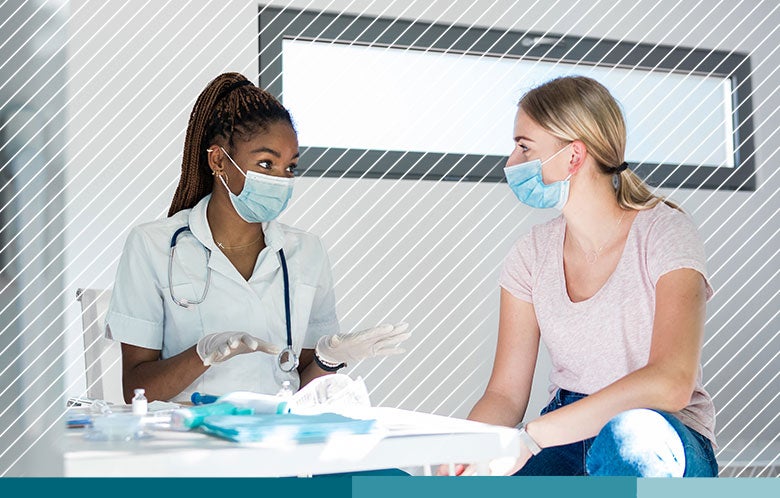Monoclonal antibodies are used to treat a variety of conditions from cancer to autoimmune disorders. The most well-known monoclonal antibody therapy for an infectious disease (i.e. antiviral monoclonal antibody) is a drug called ZMapp. Targeting Ebola virus, ZMapp is a combination of three monoclonal antibodies approved for use in 2014 during the largest Ebola outbreak in West Africa. Early in the COVID-19 pandemic, several companies started developing monoclonal antibodies directed against another deadly virus, SARS-CoV-2.
During an immune response, B cells (also called B lymphocytes) make proteins called antibodies that target the pathogen. Many B cells participate in this response, producing a large mix of antibodies that bind to different regions of the pathogen in a process known as neutralization — essentially coating the pathogen to block it from infecting cells. A primary goal of vaccination is to elicit neutralizing antibodies to block the pathogen from infecting cells, thereby protecting vaccinated individuals from infection.
The mix of antibodies that the body makes in response to infection or vaccination targeting different sites on the pathogen are referred to as polyclonal antibodies (poly = many). In contrast, monoclonal antibodies, which are made in a lab, target just one specific part of the pathogen (mono = one). Antiviral monoclonal antibodies can still neutralize the pathogen if their target is the protein that the pathogen uses to infect cells. For SARS-CoV-2, this is the spike protein.
To date, four monoclonal antibodies targeting the SARS-CoV-2 spike protein have been authorized for use in the United States to treat high-risk outpatients who have mild-to-moderate disease with the goal of preventing progression to severe disease. These four monoclonal antibodies are called bamlanivimab, etesevimab, casirivimab, and imdevimab. In addition to being nearly impossible to pronounce, monoclonal antibodies contain the suffix “mab” for monclonal antibody. Therapy is given as an intravenous infusion, most often delivered at an infusion center in healthcare facilities with immediate access to mediations to treat severe reactions should they occur.
The rationale for outpatient therapy is that once patients are sick enough to require hospitalization, the immune response is already making its own antibodies to fight the infection and adding more is not likely to be beneficial. Doing so would be like adding salt to the ocean to increase salinity. Demonstrating that point, the ACTIV-3 trial showed that bamlanivimab did not improve recovery in hospitalized patients with COVID-19.
To the contrary, since outpatients may be in an earlier phase of infection, antiviral monoclonal antibody therapy may be effective at slowing viral replication and preventing progression to severe disease. Combination therapy of bamlanivimab plus etesevimab, or casirivimab plus imdevimab, reduced SARS-CoV-2 viral load in patients with mild-to-moderate COVID-19 in the BLAZE-1 trial and REGN-COV2 trial, respectively. While therapy reduced the amount of SARS-CoV-2 virus in patients, bamlanivimab plus etesevimab did not lessen symptoms or speed time to recovery, and these clinical outcomes were not evaluated in the other trial. However, bamlanivimab plus etesevimab did reduce COVID-19-related medical visits (0.9% with therapy compared to 5.8% with placebo, p = 0.049), though casirivimab plus imdevimab did not significantly reduce medical visits (3% with therapy compared to 6% with placebo). Together, these studies suggest that monoclonal antibody therapy may help to expedite SARS-CoV-2 viral clearance in patients with mild-to-moderate illness, which does not appear to impact symptoms but might reduce the need for medical visits and alleviate strain on healthcare systems.
Beyond efficacy, there are logistical challenges to monoclonal antibody therapy. First, the high cost of drug development and time-consuming manufacturing process have contributed to limited supply. Second, treatment and monitoring largely occurs at specialized infusion centers, which are not available at all healthcare facilities and may not be accessible to those who live far away or who have limited transportation. Finally, though the federal government is providing the drugs for free, insurance companies may charge for administration. Altogether these challenges result in inequitable delivery of monoclonal antibody therapy, potentially compounding existing socioeconomic disparities already exacerbated by the pandemic. Furthermore, treating patients with mild-to-moderate COVID-19 in an outpatient facility increases the risk of transmission at a time when they may be most infectious. Considering that infusion centers also often treat immunosuppressed individuals (such as people with cancer receiving chemotherapy), the risk of transmission to others is not insignificant.
Because antiviral monoclonal antibody therapy appears to be more effective early in disease course, it is also being tested as postexposure prophylaxis – therapy given to healthy people as a preventative measure if they have been exposed to someone with COVID-19. Regeneron has reported positive interim results for postexposure prophylaxis in a press release, potentially paving the way for this indication. However, as vaccination coverage increases globally, the need for prophylaxis will undoubtedly wane.
So, does antiviral monoclonal antibody therapy work? Measured in viral load, it appears effective. However, clinical outcomes are modest and likely only beneficial to patients at highest risk of progression during a short window early after illness onset. Taken together, along with the many barriers to administration, and monoclonal antibody therapy has had limited utility for COVID-19.



